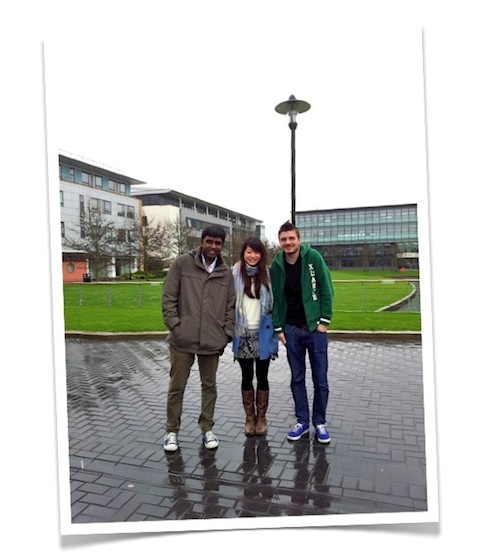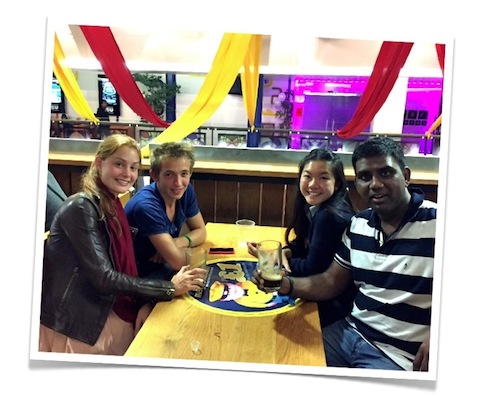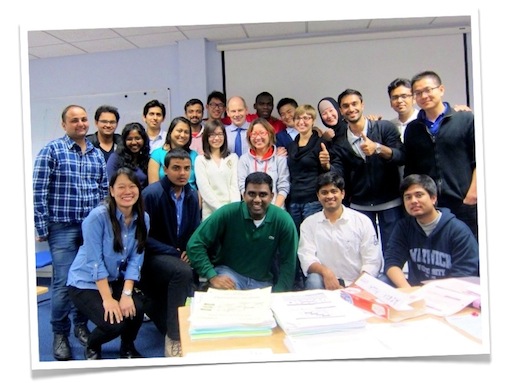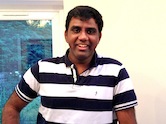Adithya Sridhar
|
India
MSE Graduate 2014-2015
|
|
"It prepares you for life in the real world of industry" |
 “I liked the teaching style a lot,” said Adithya Sridhar when we spoke to him about his time at WMG. “The best thing is that you’re treated like an adult. You are given the freedom to do your own research, thinking and work. You’re given a problem and it’s up to you how you solve it. That’s real learning – and it prepares you for life in the real world of industry.”
“I liked the teaching style a lot,” said Adithya Sridhar when we spoke to him about his time at WMG. “The best thing is that you’re treated like an adult. You are given the freedom to do your own research, thinking and work. You’re given a problem and it’s up to you how you solve it. That’s real learning – and it prepares you for life in the real world of industry.”
When Adithya arrived at Warwick in 2014, he had already gained a good deal of experience in that ‘real world’. Since graduating in Mechanical Engineering in India in 2009, he had developed his career at Nissan Motor Corporation in Japan, rising to become a Senior Engineer working on the design and development of vehicle body structures.
“I had originally considered studying for a master’s degree after I left university, but I decided to gain some work experience first,” he explained. “I joined Nissan and liked it there, so I stayed. By 2014 though, I realised that I needed to build on my technical and business skills if I wanted to achieve my career goals.”
Focused on the practical
So why did Adithya choose to study at WMG? “It would mean I would only have to take a year out, which was important,” he said. “I wanted to get back to work as soon as I could. Plus the programme covered a lot of technical subjects on a broader lever rather than being in-depth in a few. It seemed more focused on the practical rather than the theoretical, which is unusual. That suited me, as I was looking to gain knowledge that I could use at work straight away.”
Adithya went on to explain how, as he worked through his course, that practical approach was applied. “We weren’t just taught theoretical concepts, but given actual examples of how those concepts are used to solve technical problems and bring proven benefits. From there, it was up to us to research that area more thoroughly and develop our own ideas.
 “One example was an advanced composite material we learned about in class. We were taught about nano-composites, where a base material (usually plastic) incorporates glass or steel bubbles called microspheres to reduce weight and improve overall strength and performance. As part of an assignment, I researched the concept and used my automotive knowledge to create a design proposal utilising a similar nano-composite material to replace conventional steel in vehicle manufacturing.”
“One example was an advanced composite material we learned about in class. We were taught about nano-composites, where a base material (usually plastic) incorporates glass or steel bubbles called microspheres to reduce weight and improve overall strength and performance. As part of an assignment, I researched the concept and used my automotive knowledge to create a design proposal utilising a similar nano-composite material to replace conventional steel in vehicle manufacturing.”
Developing new concepts
He also talked about the group exercises that were a feature of each module’s teaching. “They were great. By working within a team, you get fresh input from different people that can change the way you look at things. You also learn how to apply the concepts you learned over the course of the week, which to me is the most critical aspect. And because teams were in competition with others, it became a lot of fun too. In the Advanced Materials and Processes module, we were asked to develop a new concept for a boat design. Others worked on kayaks or dinghies. My group went a little bit crazy and developed a proposal for a £multi-billion yacht!”
Adithya found the course structure completely different from anything he had experienced before. It involved one intensive week’s learning followed by free study time to complete a post-module assignment. “It was liberating not to have to think about exams all the while, to be honest,” he said. “This is a much better system. You’re not constantly cramming your brain with information to get through an exam. Instead, you’re able to take the time to research deeply into a subject and explore new possibilities and ideas. At the end of that, you do understand the topic rather than having your head crammed with facts that you forget really quickly.”
 For his dissertation, Adithya chose the subject: ‘Material Selection Strategies for Automotive BIW Manufacturing using the Scenario Planning Process’. Essentially, this focused on how future developments around general trends such as trade deals, international relations, emissions, automated cars and electric vehicles would affect mass manufacturers in terms of the materials they select. Having researched social, economic, political and technical trends, he came up with possible scenarios that could face the industry in the next 20 years, then illustrated how current material selection strategies would be unable to cope with what's to come in an increasingly uncertain future.
For his dissertation, Adithya chose the subject: ‘Material Selection Strategies for Automotive BIW Manufacturing using the Scenario Planning Process’. Essentially, this focused on how future developments around general trends such as trade deals, international relations, emissions, automated cars and electric vehicles would affect mass manufacturers in terms of the materials they select. Having researched social, economic, political and technical trends, he came up with possible scenarios that could face the industry in the next 20 years, then illustrated how current material selection strategies would be unable to cope with what's to come in an increasingly uncertain future.
Career progression
After leaving WMG in 2015, Adithya returned to Nissan and its UK manufacturing centre in Cranfield, UK. Here, as a Body Design Engineer, he designs and develops closure systems for upcoming vehicles and manages systems for current models. “I’m finding that I am able to put what I learned to use here,” he commented. “But not always in a traditional sense. For example, when making a proposal to people at Director level, I’m much more aware of what they’re talking about and what they are considering, making it easier for me to put my ideas across to them. That comes from having a greater appreciation of strategic management and operations.
“My plan now is to progress to team leader, then engineering manager and onwards from there. What I gained from my time at Warwick has definitely helped me to build the understanding I need to develop my career. It was a tremendous learning experience – and a very enjoyable year too.”

